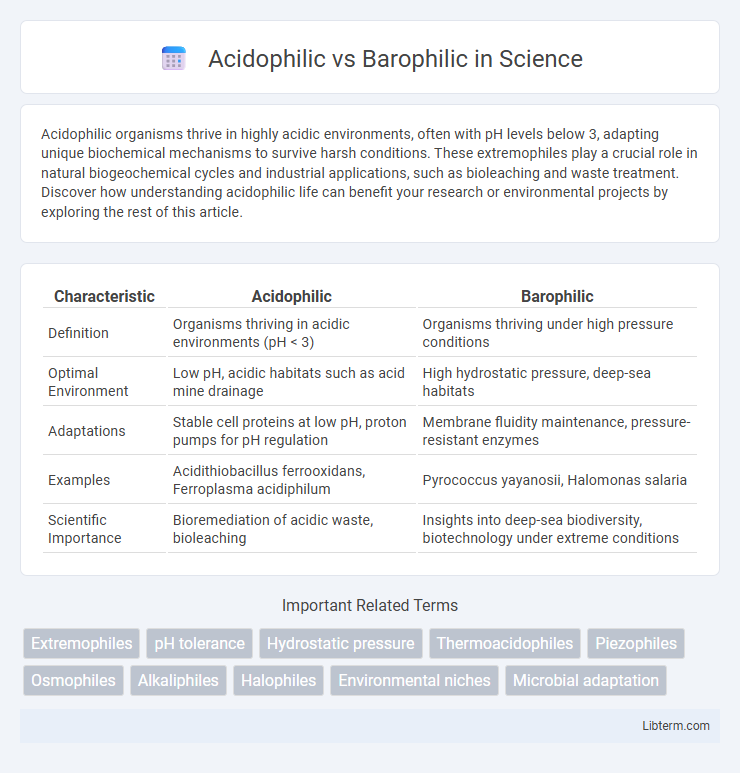Acidophilic organisms thrive in highly acidic environments, often with pH levels below 3, adapting unique biochemical mechanisms to survive harsh conditions. These extremophiles play a crucial role in natural biogeochemical cycles and industrial applications, such as bioleaching and waste treatment. Discover how understanding acidophilic life can benefit your research or environmental projects by exploring the rest of this article.
Table of Comparison
| Characteristic | Acidophilic | Barophilic |
|---|---|---|
| Definition | Organisms thriving in acidic environments (pH < 3) | Organisms thriving under high pressure conditions |
| Optimal Environment | Low pH, acidic habitats such as acid mine drainage | High hydrostatic pressure, deep-sea habitats |
| Adaptations | Stable cell proteins at low pH, proton pumps for pH regulation | Membrane fluidity maintenance, pressure-resistant enzymes |
| Examples | Acidithiobacillus ferrooxidans, Ferroplasma acidiphilum | Pyrococcus yayanosii, Halomonas salaria |
| Scientific Importance | Bioremediation of acidic waste, bioleaching | Insights into deep-sea biodiversity, biotechnology under extreme conditions |
Introduction to Extremophiles
Extremophiles are organisms thriving in environments with extreme conditions, such as high acidity or pressure. Acidophilic extremophiles flourish in acidic habitats with pH levels often below 3, utilizing specialized enzymes and cellular mechanisms to maintain stability and function. Barophilic extremophiles, also known as piezophiles, inhabit high-pressure environments like deep-sea trenches, adapting their membrane composition and protein structures to withstand pressures exceeding 100 MPa.
Defining Acidophilic Organisms
Acidophilic organisms thrive in highly acidic environments, typically with a pH below 3, by maintaining internal pH homeostasis and utilizing specialized enzymes adapted to low pH conditions. These microorganisms include certain bacteria and archaea found in acid mine drainage, sulfur springs, and acidic soils, demonstrating metabolic pathways that enable survival in extreme acidity. In contrast, barophilic organisms are adapted to high-pressure habitats, such as deep-sea environments, where pressure rather than pH is the defining factor for their ecological niche and physiological adaptations.
Characteristics of Barophilic Microbes
Barophilic microbes thrive in high-pressure environments such as deep-sea trenches, exhibiting specialized cellular adaptations like stabilized membrane lipids and pressure-resistant enzymes that maintain functionality under extreme hydrostatic pressure. These organisms often possess unique protein structures and efficient DNA repair mechanisms to counteract pressure-induced damage, enabling survival and metabolic activity at depths exceeding 1,000 meters. Barophilic microbes play critical roles in deep ocean ecosystems, contributing to nutrient cycling and organic matter decomposition under extreme conditions.
Environmental Niches: Acidic vs. High Pressure
Acidophilic microorganisms thrive in highly acidic environments with pH levels often below 3, commonly found in acid mine drainage, sulfuric hot springs, and acidic soils. Barophilic organisms adapt to extreme high-pressure habitats such as deep-sea hydrothermal vents, subduction zones, and oceanic trenches, with pressures exceeding 100 MPa. These specialized adaptations enable survival and metabolic activity in environmental niches characterized by low pH or elevated pressure, respectively.
Cellular Adaptations in Acidophiles
Acidophilic organisms exhibit unique cellular adaptations such as highly impermeable cell membranes to prevent proton influx in low pH environments, and specialized proton pumps that actively expel excess H+ ions to maintain cytoplasmic pH homeostasis. Their proteins and enzymes are structurally adapted to function optimally under acidic conditions, often stabilized by increased ionic bonds and hydrogen bonding. In contrast, barophilic organisms demonstrate adaptations mainly related to pressure tolerance, with membrane fluidity modulation and pressure-resistant enzyme conformations rather than extensive acid-resistance mechanisms.
Pressure-Resilient Mechanisms in Barophiles
Barophilic organisms thrive in extreme pressure environments by employing unique pressure-resilient mechanisms such as specialized membrane lipids that maintain fluidity and protein structures adapted to withstand high hydrostatic pressure. Acidophilic microbes, in contrast, specialize in low pH environments but do not possess these specific adaptations for high-pressure tolerance. The molecular stability in barophiles includes enhanced chaperone proteins and modifications in enzyme kinetics that prevent denaturation under intense pressure conditions common in deep-sea habitats.
Comparison of Metabolic Pathways
Acidophilic organisms thrive in low pH environments by utilizing metabolic pathways that enhance proton extrusion and maintain intracellular pH homeostasis, often relying on sulfur oxidation or iron metabolism for energy. Barophilic organisms, adapted to high-pressure deep-sea habitats, exhibit metabolic pathways optimized for pressure-resistant enzyme functionality and increased membrane fluidity, typically focusing on anaerobic respiration or methane metabolism. The key metabolic distinction lies in acidophiles' emphasis on proton gradients and acid resistance versus barophiles' adaptation to pressure-induced changes affecting electron transport and substrate utilization efficiency.
Industrial and Biotechnological Applications
Acidophilic microorganisms, thriving in low pH environments, are utilized in bioleaching processes for metal recovery and bioremediation of acidic mine drainage, enhancing industrial waste treatment efficiency. Barophilic (piezophilic) microbes, adapted to high-pressure conditions, play a crucial role in deep-sea biotechnological applications such as enzyme production for pharmaceutical synthesis and degradation of pollutants under extreme pressures. The integration of acidophilic and barophilic microbial systems offers innovative solutions in industrial biotechnology, optimizing bioprocesses under harsh environmental conditions.
Challenges in Cultivating Acidophilic and Barophilic Species
Cultivating acidophilic species requires maintaining extremely low pH conditions, often below pH 3, which poses corrosion risks to equipment and necessitates specialized acid-resistant materials. Barophilic species demand high-pressure environments, sometimes exceeding 100 MPa, making standard laboratory apparatus unsuitable and requiring complex pressurized bioreactors to simulate deep-sea conditions. Both acidophilic and barophilic cultivation face challenges in replicating their extreme habitats, limiting large-scale studies and industrial applications.
Future Research Directions and Implications
Future research directions in acidophilic and barophilic microorganisms emphasize the exploration of their genetic adaptations to extreme pH and pressure environments, leveraging metagenomics and proteomics for novel enzyme discovery. Advancements in biotechnology can harness these extremophiles for sustainable industrial applications, such as bioleaching in acid mine drainage and biocatalysis under high-pressure conditions. Understanding their survival mechanisms provides insights into astrobiology and the potential for life in extraterrestrial extreme environments.
Acidophilic Infographic

 libterm.com
libterm.com